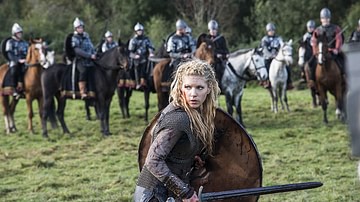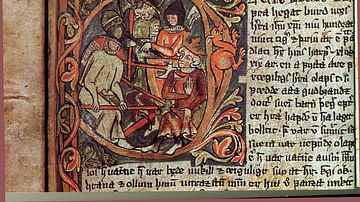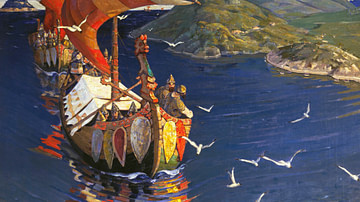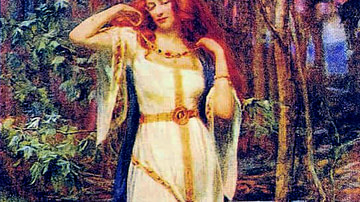In 2017 CE, Uppsala University archaeologist Charlotte Hedenstierna-Jonson published her study of a Viking grave discovered in Birka, Sweden in the 1800's CE which she and her team had revisited. She claimed that what was formerly understood as a Viking warrior's grave was that of a woman, confirmed by DNA tests, and that this proved that female Viking warriors existed during the Viking Age (c. 790-1100 CE). However, Hedenstierna-Jonson's claims quickly unraveled when challenged by professor Judith Jesch, an expert not just on the Vikings but also on women in the Viking Age, who pointed out multiple problems with the procedures involved and the conclusions the team came to.
Jesch's opinion, which is also that of the majority of scholars, is that there were no female Viking warriors as this would have been antithetical to the Viking ethos. Even though women shared equal rights with men (they could own land, initiate divorce, serve as clergy, and run their own businesses), their sphere of influence was largely domestic. Women took care of the home, the elderly relatives, and the children and were unlikely to be tolerated slipping those responsibilities to join men in battle. Norse literature and mythology, however, depicts a number of legendary women who do precisely that.
These women are described either in the Icelandic sagas of the 12th and 13th centuries CE, in the work of Snorri Sturluson (1179-1241 CE) – an Icelandic mythographer who wrote down and preserved earlier Norse works which had been transmitted orally – or in the historical and semi-historical works of other writers such as the Dane Saxo Grammaticus (c. 1160-c. 1220 CE). All of these accounts, of course, post-date the Viking Age and the sagas, especially, are considered unreliable as they often relate magical or mystical events which cannot be corroborated. Even so, they reflect a Norse admiration for the strong woman who takes it upon herself to get what she wants and go where she pleases.
ShieldMaidens, Valkyries & Heroines
The most famous type of mortal warrior woman known from the sagas is the shieldmaiden, who is mirrored in the spiritual realm of the afterlife by the Valkyries. The shieldmaiden was allegedly a woman who took up arms and armor and fought in battle alongside men. The best-known account of this comes from Saxo Grammaticus in his description of the Battle of Bråvalla (or Brávellir) (c. 750 CE though its historicity has been challenged) in his early 13th-century CE Gesta Danorum where he claims 300 shieldmaidens fought for the Danes. The Valkyries, of course, were the supernatural women warriors who chose the dead in battle and led them to Odin's hall of Valhalla.
This concept of a strong woman warrior is epitomized in the Swedish legend Blendasägnen which tells of the heroine Blenda of Småland (c. 500 or c. 750 CE) who saves her country from invasion by the Danes by inviting the Danish warriors to a feast, getting them drunk, and – together with her army of women – killing them all while they sleep. This story first appears in print in the 17th century CE though it is thought to be much older. There is no way to verify its historicity but, as far as the image of the female warrior is concerned, there is no need to. Whether Blenda actually defeated the Danes is not as important as the fact the legend exists and was popular enough to be repeated. Clearly, if the legend is indeed that old, Norse culture respected women enough to elevate them to the same level as the great heroes.
This same paradigm can be seen in the Icelandic sagas and the myths of the Norse and is epitomized in ten Norse female figures:
- Skadi – goddess of hunting and skiing.
- Freyja – goddess of fertility, love, and luck.
- Brynhild – the Valkyrie who becomes mortal, avenges herself.
- Lagertha – the victorious shieldmaiden.
- Hervor – wielder of the magic sword Tyrfing.
- Freydis Eiríksdóttir – explorer and defender of her party.
- Gudrid Thorbjarnardóttir – explorer in North America (Vinland).
- Sigrid the Proud – ruled on her own, killed her suitors.
- Unn the Deep-Minded – settled Iceland, commanded her own fleet.
- Olga of Kiev – regent of Kievan Rus, avenged her husband's death.
Skadi
Skadi is the daughter of the giant Thjazi who was killed by the god Thor of Asgard. Since her father had no males to avenge him, Skadi “took helmet and all the weapons of war and went to Asgard to avenge her father” (Lindow, 268). Thus appearing at the gates fully armed, she is placated by an offer by the Asgardians to choose her own husband from among them but must do so only by looking at their feet. She chooses one she thinks will be the handsome Baldr but it turns out to be Njord, god of the sea.
Skadi enjoys the mountains where she hunts and skis while Njord likes his dark, damp cave by the water. They try a compromise of living in each other's residence for nine days at a time but Skadi cannot endure it and leaves him for her mountain home. She is possibly the mother of two of the most important Norse gods, Freyr and Freyja, but no mention is made of her having a part in their upbringing. After she separates from Njord she pursues her own interests, including having a number of affairs with Odin.
Freyja
Freyja is among the most popular of the Norse pantheon and was the goddess of fertility, luck, love, lust, the afterlife, and protection. She rides through the heavens in her carriage pulled by cats and gives freely of all she has to humanity. As a fertility goddess, she was invoked by the Vikings for good harvests but also for strong children and stable marriages, which were thought to benefit from her blessings.
Her association with warfare and battles has to do with her realm in the afterlife. Freyja presides over Fólkvangr (“Field of the People”) and is said to collect half of the fallen on the battlefield for herself; the other half are gathered by Odin for Valhalla. Fólkvangr is seldom mentioned in Norse literature but, from the little there is, it seems Freyja may also watch as warriors engage in perpetual combat or, at least, there is a part of Fólkvangr reserved for these contests.
Brynhild
Brynhild (also given as Brynhildr, Brunhild, Brunhilde or Brunhilda) is a Valkyrie who, after supporting the wrong hero in a contest overseen by Odin, is made mortal and is imprisoned in a castle behind a wall of shields, asleep within a ring of fire, until rescued by a champion. The hero Sigurd rescues her and gives her a ring, promising to marry her, but must first go to the court of the king Gjuki. Gjuki's wife, a sorceress, wants Sigurd to marry her daughter Gudrun and gives Sigurd a potion which makes him forget Brynhild.
The sorceress also orchestrates Brynhild's rescue by her son Gunnar who will then marry her, but Gunnar cannot cross the ring of fire. Sigurd shape-shifts into Gunnar's form, rescues Brynhild, and she marries Gunnar, believing he was the one who rescued her. In an argument with Gudrun, Brynhild learns that it was Sigurd who rescued her but then forsook her and swears revenge on them all. She kills Sigurd's young son and then has Sigurd killed in his sleep. As his funeral pyre is lighted, she leaps into it and dies with him. As she rides with him to the afterlife in Hel, she encounters a giantess who chides her for her behavior but Brynhild is unrepentant, saying how she and Sigurd will now live their lives together as they were intended. According to the sagas, they somehow had a daughter in the midst of all this drama: Aslaug, one of the wives of Ragnar Lothbrok.
Lagertha
Lagertha (also known as Ladgerda) is only known from Chapter IX of Saxo Grammaticus' Gesta Danorum ('History of the Danes'). The legendary hero Ragnar Lothbrok comes to Norway to avenge the death of his grandfather Siward and the humiliation of his wives and kinfolk at the hands of Frø, the King of Sweden. He is greeted by a number of women dressed as men who volunteer to help him and, as Saxo writes,
...among them was Ladgerda, a skilled female warrior who, though a maiden, had the courage of a man and fought in front among the bravest with her hair loose over he shoulders. All marveled at her matchless deeds, for her locks flying down her back betrayed that she was a woman. (IX).
Ragnar is so impressed by her (he even attributes the victory to her specifically) that he decides to make her his wife, but Lagertha posts a bear and a dog outside her house to guard against him. Ragnar kills both animals, marries her, and they have two daughters but later, when he remembers how she had tried to set the bear and dog to attack him, he divorces her and marries another woman, Thora. Nothing more is known of Lagertha.
Hervor
Hervor is the heroine of the 13th century CE Hervarar saga ok Heiðreks and is also the name of her granddaughter, the daughter of her son Heidrek. Hervor's father, Angantyr, had a magic sword called Tyrfing but was killed in a duel and the sword was buried with him. Hervor travels with her crew to the island of Samsø in the Kattegat region where Angantyr is buried and summons his spirit, demanding the sword. Her father's ghost pleads with her to abandon her quest but she will not be denied. Finally, he opens his grave and gives her the magic sword.
The sword brings its owner nothing but trouble and Hervor has a number of adventures before settling down and getting married. Her son Heidrek inherits the sword which causes him as many problems as it did his mother. After his death, the sword passes to his daughter Hervor, who ends up dying in battle. The most impressive part of the saga is Hervor's defiance of convention and refusal to back down at her father's grave until she is given what she came for.
Freydis Eiríksdóttir
Freydis Eiríksdóttir (c. 970-c. 1004 CE) was either a great woman warrior or an evil, conniving murderess depending on which of the two stories about her one reads. She appears in Erik the Red's Saga (where she is the heroine) and The Saga of the Greenlanders (a villainess). In Erik the Red's Saga, Freydis, daughter of Erik the Red, accompanies a party to Vinland (Newfoundland, North America). They are attacked by a group of natives and the men of the party retreat, leaving Freydis alone. She calls out to them, "Why run you away from such worthless creatures, stout men that ye are, when, as seems to me likely, you might slaughter them like so many cattle? Let me but have a weapon, I think I could fight better than any of you” (Chapter 12). Even though she is unwell (possibly pregnant) and alone, Freydis grabs a sword from a dead comrade and, tearing open her shirt and beating her breasts with the blade, defies the enemy who retreat from her, thus saving her party.
In The Saga of the Greenlanders she accompanies her husband, his men, and two brothers/business partners to Vinland. She dislikes the brothers and feels they are too presumptuous so she frames them, telling her husband they abused and beat her and that she will divorce him if he does not avenge the insult. Her husband and his men kill the brothers and their party but will not hurt the women so Freydis kills all the women herself with an axe. It is likely that this second story, written later than the first, is an attempt to discredit the strong female figure from the earlier saga. Unlike the more clearly mythological and legendary characters discussed above, Freydis has a higher chance of reflecting an actual historical person, as the consensus is that these two sagas that mention Vinland remember real people and events that were at least partly preserved through an oral tradition.
Gudrid Thorbjarnardóttir
Gudrid Thorbjarnardóttir (b. c. 970/980 CE) was among the earliest explorers of North America, according to both The Saga of the Greenlanders and Erik the Red's Saga. She was originally from Iceland but went with her father and Erik the Red to settle Greenland. In Greenland, her husband died and she soon after married the younger brother of Leif Erikson, Thorstein, and accompanied her husband and brother-in-law on their expedition to North America where she explored Vinland with the others in the party.
Thorstein died there and Gudrid returned to Greenland where she married one Thorfinn Karlsefni and, sometime later, returned with him to Vinland to establish a permanent settlement there. Their son, Snorri Thorfinnsson, was the first European child born in North America. Like Freydis, the Gudrid of the sagas is likely rooted in an actual historical figure.
Sigrid the Proud
Sigrid the Proud (c. 927-c. 1014 CE, also known Sigrid the Haughty, Sigríð Storråda, or Sigrid Tostadottir) was a Swedish queen who refused to live by other people's rules. She was married to Erik the Victorious, king of Sweden (r. c. 970-995 CE), and after his death preferred to reign alone. She was courted by Harald Grenske of Norway and Vissavald of the Kievan Rus but recognized that both were only interested in her for her land and wealth. She invited them to a party where, after they and their men fell asleep from too much drink, she barred the doors of the hall and burned them to death to discourage future suitors. Her historicity is disputed and thus, this juicy story may be no more than legend.
The infamous Olaf Tryggvason (r. 995-1000 CE) who converted the populace of Norway to Christianity through torture, allegedly also sought her hand but insisted she convert to Christianity first. When she refused, he slapped her in public and Sigrid vowed revenge. She is said to have then married Sweyn Forkbeard for his connections and power and orchestrated the Battle of Svolder (c. 1000 CE) in which Olaf was killed.
Unn the Deep-Minded
Unn the Deep-Minded (9th century CE, also known as Aud the Deep-Minded and Unn- or Aud Ketilsdóttir) was the daughter of Ketil Flatnose of Norway who fled to Scotland following the rise of Harald Fairhair (r. 850-933 CE) in Norway. When her father and her son Thorstein died she understood her position in Scotland was precarious and went first to the Orkneys in the north and then to Iceland which she explored before settling down. She commanded a crew of men who were so loyal to her that none would enter into marriage contracts which might jeopardize Unn's property or power.
She presided over her family and lands in southern Iceland literally up until her dying day. On the day of the marriage of her grandson, Olaf Feilan, she oversaw the preparations and service and then retired nobly to her bedchambers where she died in her sleep.
Olga of Kiev
Olga of Kiev is better known as St. Olga (d. 969 CE) of Kievan Rus. Although she is definitely understood as an actual historical figure, the account of her early reign as regent for her son Sviatoslav I (r. 945-972 CE) in the Russian Primary Chronicle (composed c. 1113 CE) contains a number of mythic/legendary elements which places her among the legendary female Viking (Varangian) warriors.
Olga was the wife of Igor of Kiev (r. 912-945 CE), who was the son of Rurik (r. 862-879 CE) and the adopted son of Oleg the Prophet (r. 879-912 CE). Igor's excessive greed resulted in his assassination by the Drevlian tribe (a tribe of Early East Slavs). Afterwards, the Drevlians wanted Olga to marry their prince Mai to consolidate the region but Olga was only interested in avenging her dead husband.
She first requested emissaries from the Drevlians whom she tricked into being carried “in honor” in a boat toward her residence and then had them dumped into a pit and buried alive. She then asked for the wisest among the Drevlians to come to her palace and, after inviting them to bathe before dinner, set fire to the bathhouses and burned them alive. She then requested the Drevlians prepare a great funeral feast to honor Igor, allowed everyone there to become drunk, and had her soldiers murder them all.
Her final act of revenge was to drive the Drevlians into the city of Iskorosten, where Igor had been killed, and then lay siege. When she found she could not take the city, she offered the lightest terms: she demanded three pigeons and three sparrows from each home. When these were delivered, she had her soldiers fasten sulphur to their claws and release them and, when they returned to their nests in the city, they set everything on fire. The entire city burned and those who survived were killed or sold into slavery but Olga spared a certain number so they could continue to pay her tribute.
Conclusion
All of these women, whether they were active warriors or strong female rulers, embodied the Viking ideal of independence and personal strength even though they were, largely, idealized women; there is no evidence of actual shieldmaidens. Judith Jesch has noted that the interpretation of the Birka, Sweden warrior's grave as that of a women warrior by Charlotte Hedenstierna-Jonson is symptomatic of a general 21st-century CE fascination with female Viking warriors. She comments:
I have always thought (and to some extent still do) that the fascination with women warriors, both in popular culture and in academic discourse, is heavily, probably too heavily, influenced by 20th-and 21st century desires. (Newitz, 1)
While that may be, there was obviously an equally strong fascination in the past as evidenced by the work of Saxo Grammaticus and the Norse sagas. It seems clear that the Norse culture valued women enough to not only include female deities in their pantheon but also attribute to them the same martial skills and ability to determine their own fate as men were allowed.
There are, of course, strong female deities in the literature and mythology of many ancient civilizations. The Greeks had their amazons and powerful goddesses like Athena and the Romans her counterpart, Minerva and other deities like Fortuna, who decided a person's good or bad luck in life. Even so, actual women in Greece and Rome did not have the same level of autonomy that Norse women enjoyed. Among the most ancient civilizations which worshipped female deities, only Egypt recognized women's rights on par with those of men.
In Norse culture, however, even after the coming of Christianity which notoriously and repeatedly denied women equality, women were not only appreciated but conceptually elevated to a status they themselves might not attain. The woman who brewed the ale would not ever be a Freyja or a Lagertha but knowing that women could be so highly honored would probably have been a great comfort.











